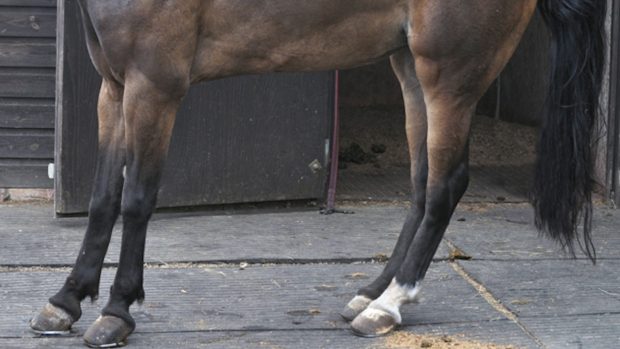Aspen, a Thoroughbred/Irish Draught (not pictured above), enjoyed competing locally with his owner, art teacher Sue Williams for a number of years. As he grew older, Aspen became prone to slight periods of laminitis, but, in September 1996, he suffered a bout that Sue found particularly difficult to clear up.
Sue says: “Despite a carefully controlled diet, I presumed it was grass-induced.” In August the following year, Aspen again contracted laminitis, this time complicated by foot abscesses. “I started to read everything there was to read about laminitis,” she says, and again, through careful management, managed to overcome the problems.
At the age of 28, Aspen, once again showed critical signs of the disease. “I almost began to believe it was time to let him go, but I was reluctant as he is a horse with such a strong personality that I knew he wasn’t ready,” says Sue.
Sue’s farrier, Mick Joliffe, suggested taking Aspen to Richard Jones at the Bell Equine veterinary clinic. At the clinic, Cushing’s disease was suggested as the source of the problems. One of the vets looking after the case, Ingunn Risnes, says: “Cushing’s disease is more common in older ponies. Horses are not as susceptible, but Aspen was not a typical laminitis candidate, particularly as he was not overweight and he also had some difficulty shedding his coat, which is a common clinical sign with Cushing’s cases.”
Aspen had his feet X-rayed and blood tests were taken. Corrective farriery was decided on and heart-bar shoes were put on. Blood tests revealed Cushing’s disease and the vets decided to give Aspen pergolide – a “dopaminergic agonist” that works on the pituitary gland – more commonly used for humans, but selectively used on horses.
Ingunn says: “Cushing’s disease can cause varying clinical signs, from barely perceptible to serious illness. Careful management through correct farriery, diet and clipping come first in our approach. In a lot of cases, that is all that is necessary. Treating with drugs is expensive and we have to consider what is best for that particular case.”
A month later, Aspen was walking out and was more comfortable with careful foot support, good nursing and appropriate medication. However, unfortunately for Sue and her horse, the side-effects of the drug meant that Aspen’s appetite was suppressed for a few months.
“He ate his hard food, but was picky with hay. This, plus management to prevent any recurrence of laminitis, contrived to make him a little thin,” says Sue.
A year later, Aspen is able to be hacked out happily and is still fond of a gallop round his field when allowed. “The drug is expensive, but I wanted to keep Aspen as he seemed so full of life, and he still enjoys a good shy while hacking,” says Sue. This year, she hopes to forestall any recurrence of the problem, and she, the vets and her farrier will continue to watch Aspen carefully.





